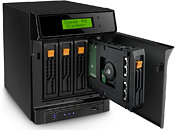- Joined
- Oct 9, 2007
- Messages
- 47,235 (7.55/day)
- Location
- Hyderabad, India
| System Name | RBMK-1000 |
|---|---|
| Processor | AMD Ryzen 7 5700G |
| Motherboard | ASUS ROG Strix B450-E Gaming |
| Cooling | DeepCool Gammax L240 V2 |
| Memory | 2x 8GB G.Skill Sniper X |
| Video Card(s) | Palit GeForce RTX 2080 SUPER GameRock |
| Storage | Western Digital Black NVMe 512GB |
| Display(s) | BenQ 1440p 60 Hz 27-inch |
| Case | Corsair Carbide 100R |
| Audio Device(s) | ASUS SupremeFX S1220A |
| Power Supply | Cooler Master MWE Gold 650W |
| Mouse | ASUS ROG Strix Impact |
| Keyboard | Gamdias Hermes E2 |
| Software | Windows 11 Pro |
Seagate today introduced the industry's highest-capacity, 4-bay and 2-bay, desktop network attached storage solutions to help data-intensive small business address evolving storage needs. The BlackArmor NAS 440 network storage server and BlackArmor NAS 220 network storage server, extend the capacity range of Seagate's BlackArmor family of storage solutions, enabling businesses to now scale from 1TB to 12TB to help keep pace with the growing stores of high-definition multi-media files and business critical data. Initially, both solutions will come pre-populated with 3TB drives in each bay and will be offered exclusively for 30-days through Seagate.com and select online retailers. For the first 30 days, CDW will provide the 12TB BlackArmor NAS 440 for a manufacturer's suggested retail price (MSRP) of $1,899.99, and NewEgg will sell the BlackArmor NAS 220 6TB for a manufacturer's suggested retail price (MSRP) of $649.99.


Both the BlackArmor NAS 440 and BlackArmor NAS 220 network storage servers are designed to help businesses with up to 50 employees and little or no IT support, centralize and secure data with maximum uptime by delivering:
For more information, visit the product pages of the BlackArmor 440 and BlackArmor 220.
View at TechPowerUp Main Site


Both the BlackArmor NAS 440 and BlackArmor NAS 220 network storage servers are designed to help businesses with up to 50 employees and little or no IT support, centralize and secure data with maximum uptime by delivering:
- Software management tools that are compatible across the family to provide a consistent user experience and future growth path with minimal training or the need for additional support.
- Support for Microsoft Active Directory 2000, 2003, 2008 for populating users and groups.
- Unparalleled security with powerful hardware-based encryption.
- Remote access with the included, web-based Seagate Global Access service and FTP functionality.
- Quick start features, ability to easily view or map shared volumes to a computer, or back up the PC from which you are working from, using the BlackArmor Discovery tool software, which automatically displays all BlackArmor NAS products connected to the network.
- Full-system backup and recovery helps protect everything on your PC's hard drive including the operating system, programs and settings. In the event of a system crash or failure, your computer can be restored to a previous point in time with SafetyDrill software.
- Event email notification to alert the user about status and changes to the server.
- Additional USB ports to connect extra USB storage devices, easily share a USB printer or connect an uninterrupted power supply (UPS) to safeguard from power failure.
For more information, visit the product pages of the BlackArmor 440 and BlackArmor 220.
View at TechPowerUp Main Site








